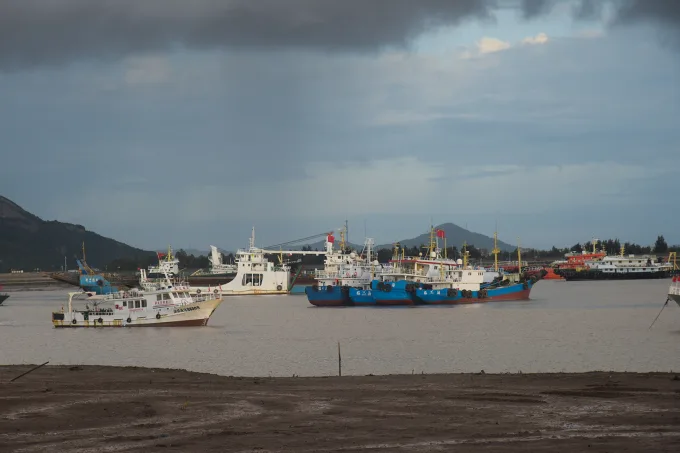
A powerful typhoon is advancing toward Taiwan, resulting in at least two fatalities and hundreds of injuries as authorities shut down financial markets, schools, and offices. Taiwan is experiencing deteriorating conditions as Typhoon Gaemi brings heavy rainfall, strong winds, and a dangerous storm surge.
The two confirmed deaths include a woman in Kaohsiung City, who was crushed by a fallen tree while riding a motorcycle, and another woman in Hualien, struck by a parapet falling from a roof, according to Taiwan’s Central Emergency Operations Center. At least 201 people have been injured. Initially, the storm was expected to intensify into a super typhoon before hitting Taiwan’s northeastern coast on Wednesday afternoon. However, it veered off its projected path due to Taiwan’s mountainous terrain, lingering offshore near Hualien for over six hours instead of making landfall.

Hualien, the most populated city in eastern Taiwan, has endured extended hours of the typhoon’s harshest conditions, including winds exceeding 100 mph (160 kph), storm surge, and heavy rainfall. Rainfall has already surpassed 300 mm (1 foot) in many areas, with some mountainous regions receiving over 500 mm (1.5 feet).
The storm’s deflection is attributed to mountains disrupting its wind field, a phenomenon documented many times over the past 60 years for typhoons approaching northeast Taiwan. This interaction with land has slightly weakened Typhoon Gaemi, reducing its top winds from 230 kph (145 mph) to 205 kph (125 mph), classifying it as a strong Category 3 hurricane-equivalent, according to the Joint Typhoon Warning Center.
Taiwan frequently faces typhoons and has a strong track record in preparing for the associated damaging winds and downpours, particularly in urban areas. However, remote and mountainous regions, especially on the island’s east side, remain at higher risk, particularly from landslides. Taiwan’s Central Meteorological Agency (CMA) has issued a sea and land typhoon warning for the entire island, while President Lai Ching-te urged residents to avoid travel unless absolutely necessary.
Typhoon Gaemi has intensified in Pacific waters at record high temperatures. As the first typhoon of the season to affect Taiwan, it rapidly intensified by 96 kph (60 mph) over 24 hours, far exceeding the rapid intensification threshold of 56 kph (35 mph) in 24 hours. Scientists link this rapid intensification to the warmer oceans resulting from the human-caused climate crisis.
Most Taiwanese cities, including the capital Taipei, Hsinchu, and Kaohsiung, closed schools and offices on Wednesday, and Taiwan Railways suspended some rapid train services. Over 50,000 households in Kaohsiung were without power. Dozens of flights and all regular train services have been canceled for Wednesday and Thursday, with major airlines like EVA Air, China Airlines, and Starlux Airlines announcing disruptions due to the typhoon.
Taiwan’s defense authorities have adjusted the ongoing Han Kuang War Games due to the typhoon. These live-fire drills are Taiwan’s largest annual military exercises, critical for maintaining vigilance against potential threats from China. Defense ministry spokesperson Sun Li-fiang indicated some air and naval components would be modified in response to the typhoon.
Gaemi has also led to the closure of schools and government offices in the Philippines, with heavy rains affecting the Manila capital region and Luzon. Some flights have been canceled, and the Philippine Stock Exchange suspended trading on Wednesday. President Ferdinand Marcos Jr. reported that over 770,000 people have been impacted by the typhoon and southwest monsoon in the southern regions, with 4,500 personnel on standby for search and rescue operations.
Although weakened, Gaemi is expected to make landfall in China on Thursday as a strong Category 1 or low-end Category 2 hurricane, with winds of 145 to 160 kph (90 to 100 mph). The worst winds are predicted for coastal areas of Fujian province, where boats are taking shelter and train services will be suspended Thursday. Heavy rain is expected to spread across Fujian, southern Zhejiang, and Jiangxi provinces throughout the week. By the weekend, Gaemi’s remnants will likely bring heavy rainfall further north into areas like Henan, Shanxi, and Hebei, which have recently been severely affected by flooding.

In recent weeks, tens of thousands have been evacuated across multiple Chinese provinces following deadly floods and landslides, which have blocked highways, destroyed homes, and caused significant financial losses by wiping out crops and livestock. Torrential rains in southern, central, and eastern China have prompted major emergency response efforts, as this year’s flood season has begun two months earlier than usual.
In the past two weeks, tens of thousands of people have been evacuated across multiple provinces in China due to deadly floods and landslides. These disasters have blocked highways, destroyed homes, and caused significant financial losses by wiping out crops and livestock. Torrential rainfall has affected southern, central, and eastern parts of the country, triggering major emergency response efforts. This year’s flood season began about two months earlier than usual.

In Henan province, the floods followed a period of extreme heat, complicating efforts to grow and irrigate vital crops in central China’s agricultural heartland. Extreme rain then inundated tens of thousands of acres of farmland, forcing over 100,000 people to evacuate their homes, according to state media reports. The combination of scorching heat and severe floods within a few weeks has extended an already devastating period of extreme weather across China, which is expected to continue.
[Join our WhatsApp Channel](https://whatsapp.com/channel/0029VabITrvEAKW7DSkTfP0J)
.
This is a tragedy